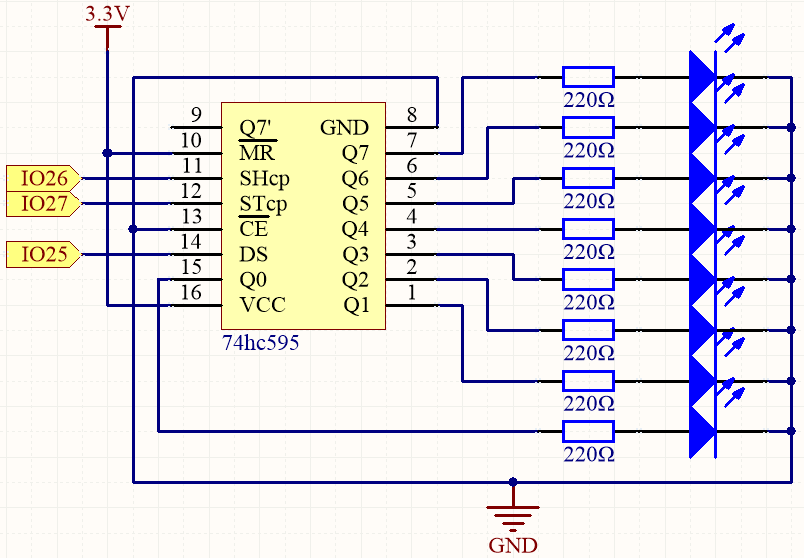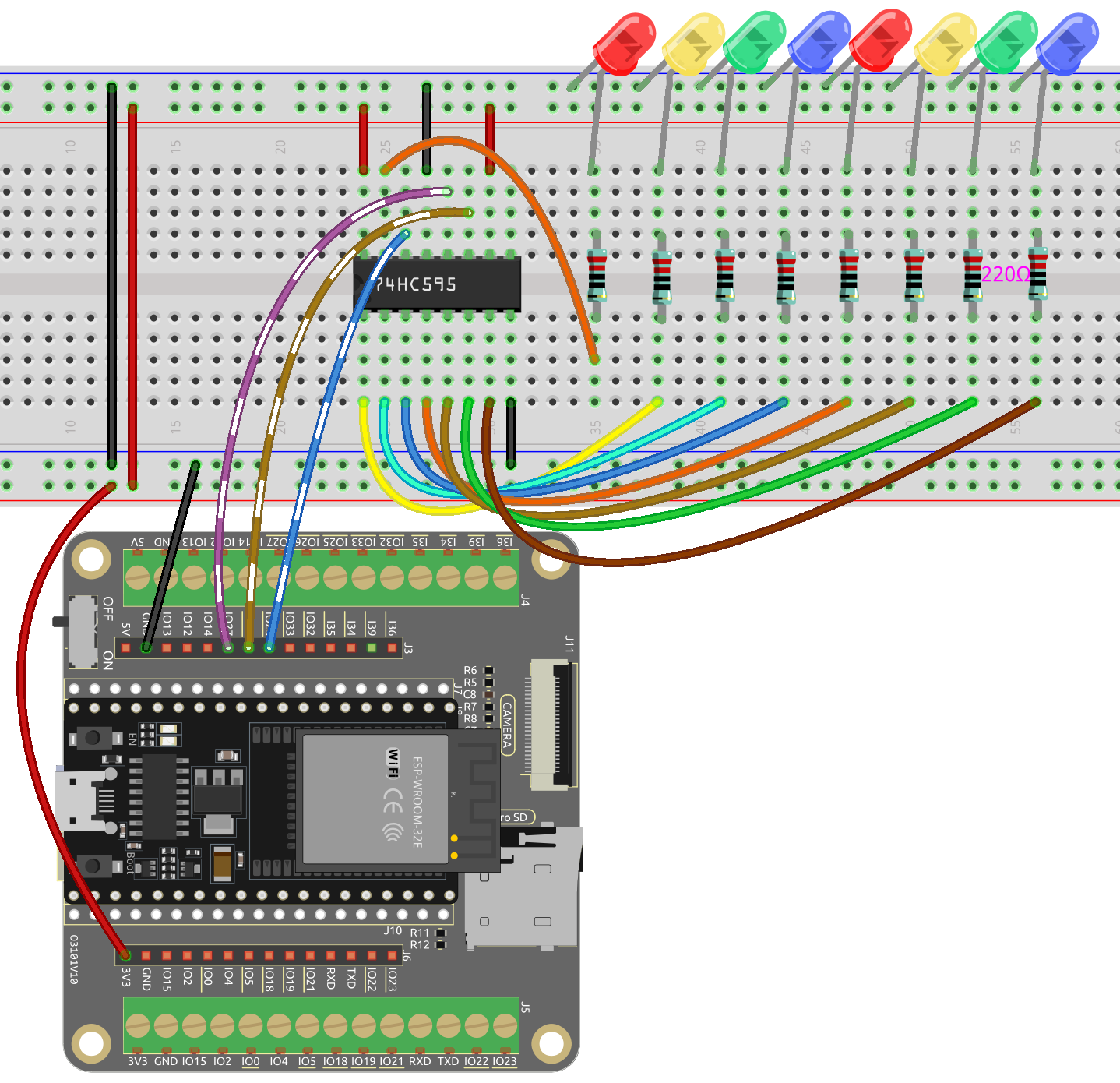2.4 Microchip - 74HC595¶
Welcome to this exciting project! In this project, we will be using the 74HC595 chip to control a flowing display of 8 LEDs.
Imagine triggering this project and witnessing a mesmerizing flow of light, as if a sparkling rainbow is jumping between the 8 LEDs. Each LED will light up one by one and quickly fade away, while the next LED continues to shine, creating a gorgeous and dynamic effect.
By cleverly utilizing the 74HC595 chip, we can control the on and off states of multiple LEDs to achieve the flowing effect. This chip has multiple output pins that can be connected in series to control the sequence of LED illumination. Moreover, thanks to the chip’s expandability, we can easily add more LEDs to the flowing display, creating even more spectacular effects.
Required Components
In this project, we need the following components.
It’s definitely convenient to buy a whole kit, here’s the link:
Name |
ITEMS IN THIS KIT |
LINK |
|---|---|---|
ESP32 Starter Kit |
320+ |
You can also buy them separately from the links below.
COMPONENT INTRODUCTION |
PURCHASE LINK |
|---|---|
- |
|
Available Pins
Here is a list of available pins on the ESP32 board for this project.
Available Pins |
IO13, IO12, IO14, IO27, IO26, IO25, IO33, IO32, IO15, IO2, IO0, IO4, IO5, IO18, IO19, IO21, IO22, IO23 |
Schematic

When MR (pin10) is high level and CE (pin13) is low level, data is input in the rising edge of SHcp and goes to the memory register through the rising edge of SHcp.
If the two clocks are connected together, the shift register is always one pulse earlier than the memory register.
There is a serial shift input pin (DS), a serial output pin (Q7’) and an asynchronous reset button (low level) in the memory register.
The memory register outputs a Bus with a parallel 8-bit and in three states.
When OE is enabled (low level), the data in memory register is output to the bus(Q0 ~ Q7).
Wiring

Code
Note
Open the
2.4_microchip_74hc595.pyfile located in theesp32-starter-kit-main\micropython\codespath, or copy and paste the code into Thonny. Then, click “Run Current Script” or press F5 to execute it.Make sure to select the “MicroPython (ESP32).COMxx” interpreter in the bottom right corner.
import machine
import time
# Initialize the pins for the 74HC595 shift register
sdi = machine.Pin(25, machine.Pin.OUT) # DS
rclk = machine.Pin(27, machine.Pin.OUT) # STcp
srclk = machine.Pin(26, machine.Pin.OUT) # SHcp
# Define the hc595_shift function to shift data into the 74HC595 shift register
def hc595_shift(dat):
# Set the RCLK pin to low
rclk.off()
# Iterate through each bit (from 7 to 0)
for bit in range(7, -1, -1):
# Extract the current bit from the input data
value = 1 & (dat >> bit)
# Set the SRCLK pin to low
srclk.off()
# Set the value of the SDI pin
sdi.value(value)
# Clock the current bit into the shift register by setting the SRCLK pin to high
srclk.on()
# Latch the data into the storage register by setting the RCLK pin to high
rclk.on()
num = 0
# Shift data into the 74HC595 to create a moving LED pattern
for i in range(16):
if i < 8:
num = (num << 1) + 1 # Shift left and set the least significant bit to 1
elif i >= 8:
num = (num & 0b01111111) << 1 # Mask the most significant bit and shift left
hc595_shift(num) # Shift the current value into the 74HC595
print("{:0>8b}".format(num)) # Print the current value in binary format
time.sleep_ms(200) # Wait 200 milliseconds before shifting the next value
During script execution, you will see the LED light up one by one, and then turn off in the original order.
How it works?
This code is used to control an 8-bit shift register (74595), and output different binary values to the shift register, with each value displayed on an LED for a certain period of time.
The code imports the
machineandtimemodules, where themachinemodule is used to control hardware I/O, and thetimemodule is used for implementing time delays and other functions.import machine import time
Three output ports are initialized using the
machine.Pin()function, corresponding to the data port (SDI), storage clock port (RCLK), and shift register clock port (SRCLK) of the shift register.# Initialize the pins for the 74HC595 shift register sdi = machine.Pin(25, machine.Pin.OUT) # DS rclk = machine.Pin(27, machine.Pin.OUT) # STcp srclk = machine.Pin(26, machine.Pin.OUT) # SHcp
A function called
hc595_shift()is defined to write an 8-bit data to the shift register.def hc595_shift(dat): # Set the RCLK pin to low rclk.off() # Iterate through each bit (from 7 to 0) for bit in range(7, -1, -1): # Extract the current bit from the input data value = 1 & (dat >> bit) # Set the SRCLK pin to low srclk.off() # Set the value of the SDI pin sdi.value(value) # Clock the current bit into the shift register by setting the SRCLK pin to high srclk.on() # Latch the data into the storage register by setting the RCLK pin to high rclk.on()
About the
forloop.for i in range(16): if i < 8: num = (num << 1) + 1 # Shift left and set the least significant bit to 1 elif i >= 8: num = (num & 0b01111111) << 1 # Mask the most significant bit and shift left hc595_shift(num) # Shift the current value into the 74HC595 print("{:0>8b}".format(num)) # Print the current value in binary format time.sleep_ms(200) # Wait 200 milliseconds before shifting the next value
The variable
iis used to control the output binary value. In the first 8 iterations, the value of num will be successively 00000001, 00000011, 00000111, …, 11111111, which is left-shifted by one bit and then added by 1.In the 9th to 16th iterations, the highest bit of 1 is first changed to 0, and then left-shifted by one bit, resulting in the output values of 00000010, 00000100, 00001000, …, 10000000.
In each iteration, the value of
numis passed to thehc595_shift()function to control the shift register to output the corresponding binary value.At the same time as outputting the binary value, the
print()function outputs the binary value as a string to the terminal.After outputting the binary value, the program pauses for 200 milliseconds using the
time.sleep_ms()function, so that the value on the LED remains displayed for a certain period of time.